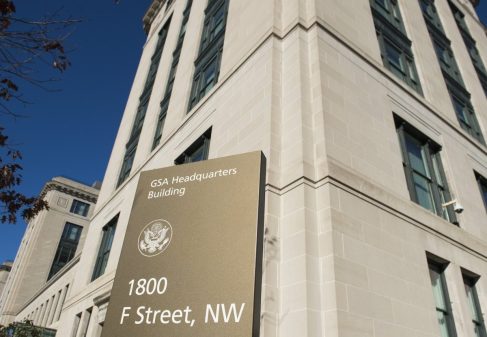 Army Gen. Martin E. Dempsey, chairman of the Joint Chiefs of Staff, testifies on the impact of sequestration before the Senate Armed Services Committee in Washington, D.C., Feb. 12, 2013. Other defense leaders, including Deputy Defense Secretary Ashton B. Carter, center, also testified on the issue. (Photo: DOD/Myles Cullen)
Army Gen. Martin E. Dempsey, chairman of the Joint Chiefs of Staff, testifies on the impact of sequestration before the Senate Armed Services Committee in Washington, D.C., Feb. 12, 2013. Other defense leaders, including Deputy Defense Secretary Ashton B. Carter, center, also testified on the issue. (Photo: DOD/Myles Cullen)Earlier this week, a nearly full roster of the Joint Chiefs of Staff testified before the Senate Armed Forces Committee to discuss the effects of sequestration.
To help put the effects into perspective, FedScoop compiled key numbers mentioned during testimony from each department of the military.
Sequestration is scheduled to take place March 1 unless Congress comes to a solution to cut federal spending. If enacted, sequestration would cut more than $1 trillion from the federal budget over the next decade, including more than $85 billion this year.
Department of Defense
Quotable
“The cloud of uncertainty hanging over the department is already having lasting and irreversible effects. It needs to be dispelled and not moved to the horizon.” – Deputy Secretary of Defense Ash Carter
The numbers
- $46 billion: Total amount of cuts the department will be required to make this year alone if sequestration takes effect.
- 20 percent: Portion of Deputy Secretary Ash Carter’s salary he said he will forgo if the department’s civilian employees are furloughed. As a presidential appointee, Carter is not subject to furloughs.
- 1,500 to 2,000: Employees the Department of Defense hires each week. If sequestration takes effect, there will be a department-wide hiring freeze.
- 86 percent: Percentage of DOD civilian jobs that are outside of the Washington, D.C. metropolitan area.
- $5 billion: The amount the department will save by furloughing its 800,000 civilian employees, making up less than 10 percent of the total sequestration cuts this fiscal year.
U.S. Army
Quotable
“The domestic impacts of [sequestration and the uncertain fiscal environment] are only now beginning to be felt and will be magnified over the next several years.” – Army Chief of Staff Gen. Ray Odierno
The numbers
- $12 billion: The total amount sequestration will cut from the Army’s budget over the final seven months of the fiscal year.
- 251,000: Army civilian employees subject to furlough one day a week for 22 weeks if sequestration takes effect.
- 16: Military intelligence training courses being cut, resulting in 4,000 fewer soldiers with the intelligence skills the Army requires.
- $2 billion: The reduction in Army base sustainment funds, a 70 percent drop from what has historically required to run the Army’s installations.
- 81,000: Army soldiers committed to operations around the world, including 58,000 in Afghanistan.
U.S. Navy
Quotable
“Inevitably, these changes will severely damage our industrial base. Some shipyards will not be able to sustain stead construction or maintenance operations and may be closed.” – Chief of Naval Operations Adm. Jonathan Greenert
The numbers
- $11.2 billion: The total amount sequestration will cut from the Navy’s budget over the final seven months of the fiscal year.
- 2: Aircraft carrier refueling overhauls that will not be completed due to a lack of funding.
- 70 percent: Amount of ship maintenance in private shipyards and all aircraft maintenance scheduled in the third and fourth quarters of fiscal year 2013 that will be cancelled.
- 186,000: Navy civilian employees that will face furloughs, resulting in a 20 percent pay reduction.
- 5 of 6: Cancelled fiscal year 2013 ship deployments and stop all aircraft deployments to South America, stopping efforts that interdicted hundreds of tons of illegal drugs into the U.S. in 2012.
U.S. Air Force
Quotable
“If sequestration occurs, it will significantly undermine the Air Force’s readiness and responsiveness today … and mortgage the Air Force’s future health for years to come.” – U.S. Air Force Chief of Staff Mark Welsh III
The numbers
- $12.4 billion: Potential topline reduction for the U.S. Air Force if sequestration takes place.
- 203,000: Remaining flying hours in the current fiscal year that will be dropped, an 18 percent reduction.
- 31.5 million: Man hours the department will lose if it must furlough the 180,000 members of its civilian workforce.
- 10 percent: Amount cut from the operations and maintenance topline budget, approximately 22 percent of remaining funds.
- 8,000: Airmen that won’t be able to get the specialized training needed for promotion, reducing the certification levels of those career fields to critical deficiencies.
U.S. Marine Corps
Quotable
“There should be no misunderstanding; the combined effect of the CR and sequestration will have a significant effect on the global security climate.” – U.S. Marine Corps Commandant Gen. James Amos
The numbers
- $406 million: Reduction in operation and maintenance budget in relative to the president’s fiscal year 2013 budget.
- 95 percent: Amount of Marine Corps personnel that work outside the Washington, D.C. metropolitan area.
- 30 percent: Amount the Marine Corps will have to decrease operations in the Asia Pacific region.
- $38 million: Cuts in planned civilian personnel expenditures, resulting in the Marine Corps being 400 civilians short of intended fiscal year 2013 civilian workforce end strength.
- 71 percent: The amount the facility maintenance budget will be decreased.






